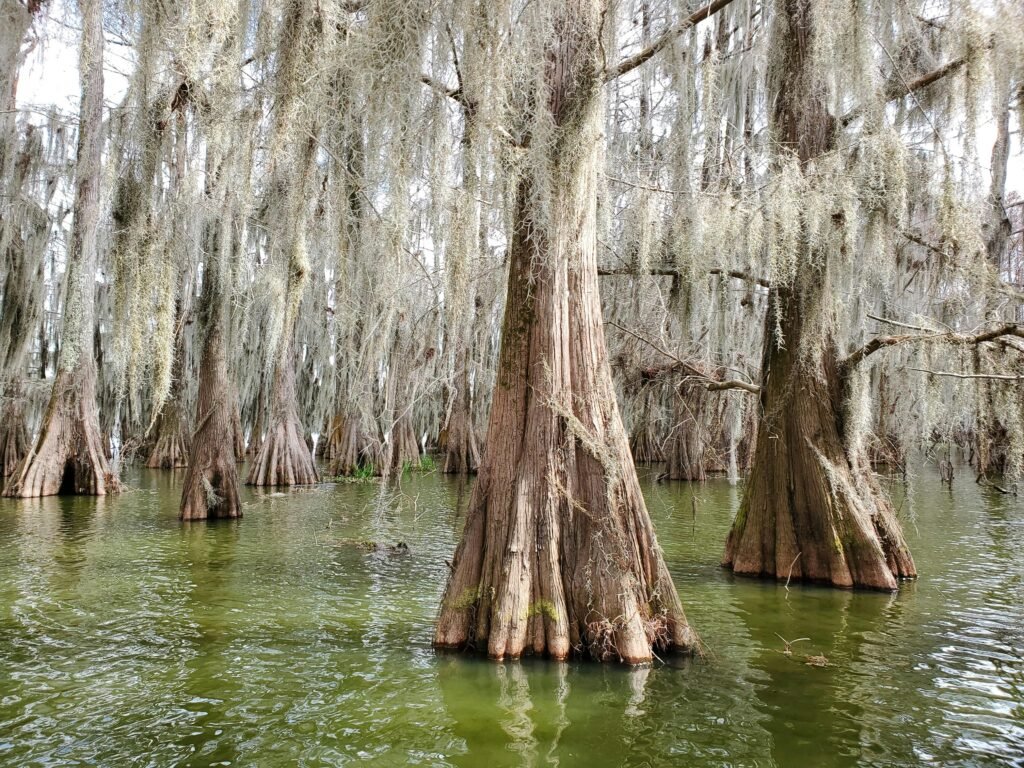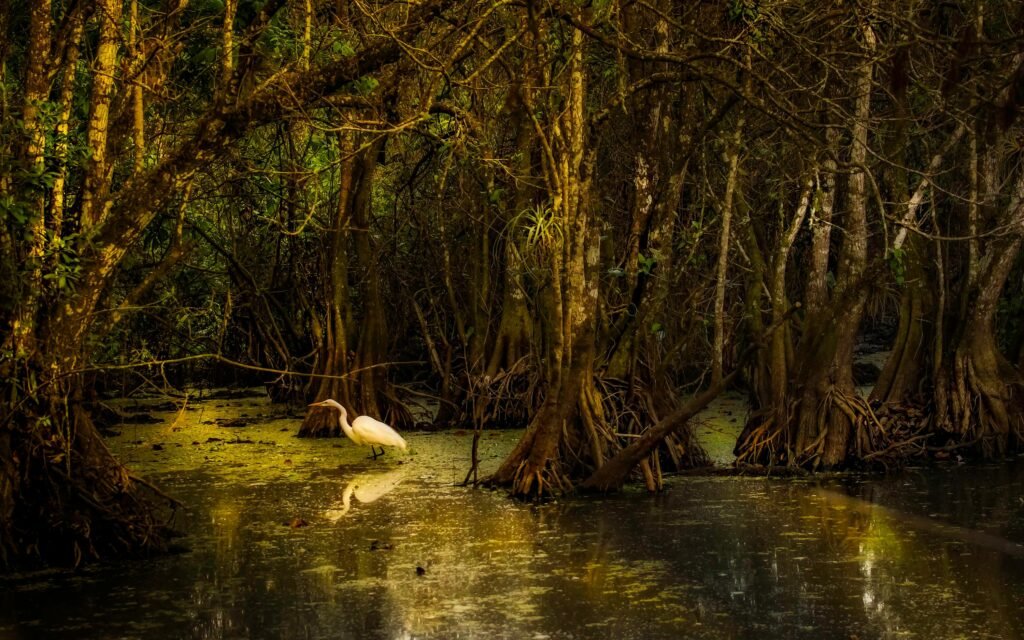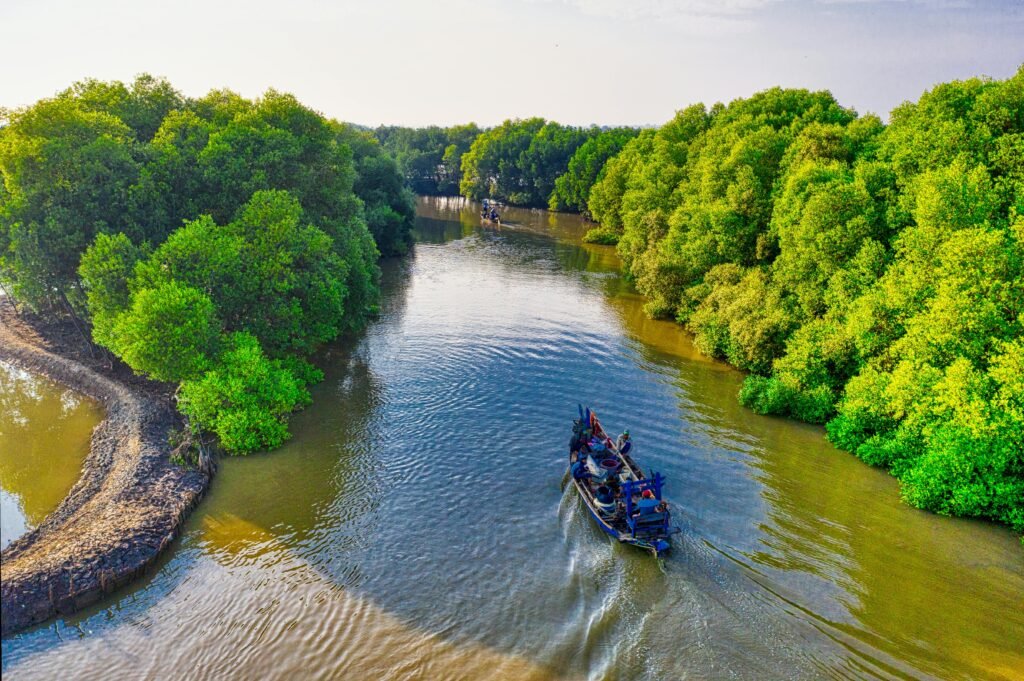Have you ever wondered, “Are there mangroves in the Everglades?” The answer to that question is “Yes.” The main types of Everglades mangrove trees are red mangrove (Rhizophora mangle), black mangrove (Avicennia germinans), and white mangrove trees.
Interestingly, the three main types of mangrove trees are layered. Red mangroves are found closest to the coastline, followed by black mangroves, and finally, white mangroves, which are located further inland among the wetlands. Each mangrove species plays a vital role in supporting and maintaining the ecosystem.
Red mangroves in the Everglades are recognized by their prop roots. The roots extend out vertically from the tree trunk, creating a distinct network of roots that help secure the tree in the soft mud of the coastline. Red mangroves also produce small yellow flowers, which then yield green fruits called propagules.
Black mangroves are distinct from the other species of mangrove everglades. These trees have what are called pneumatophores, or “breathing roots”. These roots grow vertically out of the ground and protrude above the waterline.
White mangrove everglades are found in higher elevations, usually further inland, and prefer drier conditions. Also, white mangroves do not have salt glands in their leaves, unlike red or black mangrove trees.
Ecosystem of the Florida Everglades Mangroves

These distinct species of mangrove trees make up the Everglades National Park in Florida, where you will find the largest protected mangrove forest in the Western Hemisphere. The marshlands and intertidal areas are filled with wildlife and a vibrant ecosystem.
Mangroves Everglades are found along rivers and coastal channels in the southern parts of Florida. These are the intertidal zones where saltwater from the ocean mixes with freshwater wetlands when the tides come in and out.
The mangrove trees Everglades are uniquely adapted to survive in a difficult environment. Specifically, mangrove trees are a salt-tolerant species, so they can filter out salt from the saltwater that regularly floods the intertidal areas of the Florida Everglades.
In addition to filtering water, the roots of mangrove trees anchor them to the muddy swamp beds, which helps to reduce erosion and provide a habitat for many kinds of fish, birds, animals, and insects. This allows mangrove forest everglades to thrive in an environment where other tree species would perish.
Furthermore, mangroves contribute a lot to the ecosystem’s overall health in the Florida Everglades. Not only are the root systems home to an assortment of fish, crabs, and other marine animals, but the branches of mangroves make for ideal nesting spots for many different kinds of birds. The muddy soil of the marshlands is also a prime location for birds to find food. When visiting the Everglades, you are likely to see herons, sandpipers, egrets, and many more birds wading around the mangrove trees in search of their next meal.
Benefits of Mangroves in the Everglades

Everglades mangroves play an important role in maintaining the Florida Everglades ecosystem. For starters, the roots of mangrove trees are key to reducing erosion and helping maintain a viable shoreline. Additionally, salt-filtering roots help improve water quality and even reduce pollution.
Everglades mangrove forests are also the nursery for many types of fish. In particular, mangrove roots comprise the habitat for a wide variety of fish. Some species of fish found living among the mangrove’s root systems include gray snapper, goliath grouper, spotted seatrout, and red drum. These nurseries are vital to the sport and commercial fishing industries. Without the protection offered by mangroves for spawning, the populations of numerous species of fish would collapse.
Along with fish and birds, the mangrove forests of the Florida Everglades contribute to the biodiversity found there. Microorganisms such as algae and bacteria depend on the leaves that fall off the trees. Those microorganisms are then the primary food source for various kinds of fish native to the Everglades.
It is also important to note that mangroves in the Everglades offer the first line of defense against storm surges. The roots of mangroves work to anchor the trees and form a barrier against rushes of ocean water and related debris that accompany storm surges. In turn, the marshlands are protected against further erosion and soil degradation while wildlife habitats are preserved for future offspring.
Challenges Facing Mangroves Everglades

Unfortunately, the complex ecosystem of mangrove Everglades is not free from certain challenges to its survival. Like many ecosystems around the globe, the Florida mangrove Everglades are being harmed by increasing human activity. The biggest challenge comes from pollution in the ocean, but there are also challenges arising from irrigation and invasive species.
Invasive species are animals that are not native to the Everglades. One such species, in particular, is the Burmese python. These giant snakes compete with the native animals of the Everglade mangroves for food, resulting in a decline in the number of native animals. Efforts are underway to track and remove Burmese pythons, but it is no easy task.
Conservation efforts in the mangrove Everglades are ongoing. One of the prominent players in ensuring the everglades can survive and thrive is the US National Park System’s Critical Ecosystems Studies Initiative (CESI). This research funding program helps with the collection of biological data, simulation models, and potential restoration methods that can be used to protect the mangrove Everglades from environmental degradation.
As well as the CESI, the Everglades Literacy Program, directed by the Everglades Foundation, is working to educate and train young students to get involved in conversation efforts about the Florida Everglades. The program has put together a curriculum that schools, teachers, students, and parents can use to learn about what it will take to ensure the Everglade mangroves will be sound for the foreseeable future.
The Mangrove Everglades of Florida Are Calling

It should be apparent that mangrove forests are of the utmost importance in maintaining the Everglades ecosystem. From storm surge protection to erosion reduction, wildlife habitats to enhancing biodiversity, mangrove trees are a crucial part of this beautiful marshland.
While the Everglades mangroves face challenges, one way to help protect this incredible part of Florida is to find eco-tourism services around the Everglades. A growing number of companies and services offer eco-friendly ways of exploring and enjoying Everglades National Park.
Airboat tours are a great way to visit large areas of the Everglades while helping to protect wildlife and ensure restoration efforts are not disturbed. These kinds of tours can get you up close to all the wildlife of the mangrove Everglades, especially those famous alligators.
In addition to airboat tours, you can spend time on walking wildlife tours, kayaking and canoeing tours, or simply find a campsite and pick a tent. So, what are you waiting for? A majestic adventure awaits everyone in the Florida Mangrove Everglades.
